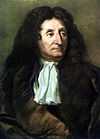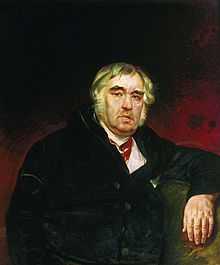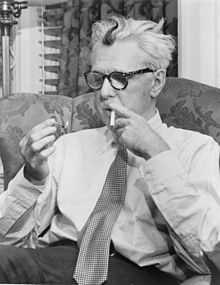Fable

Fable is a literary genre. A fable is a succinct fictional story, in prose or verse, that features animals, mythical creatures, plants, inanimate objects or forces of nature which are anthropomorphized (given human qualities such as verbal communication), and that illustrates or leads to an interpretation of a moral lesson (a "moral"), which may at the end be added explicitly in a pithy maxim.
A fable differs from a parable in that the latter excludes animals, plants, inanimate objects, and forces of nature as actors that assume speech and other powers of humankind.
Usage has not always been so clearly distinguished. In the King James Version of the New Testament, "μῦθος" ("mythos") was rendered by the translators as "fable"[1] in First and Second Timothy, in Titus and in First Peter.[2]
A person who writes fables is a fabulist.
History
The fable is one of the most enduring forms of folk literature, spread abroad, modern researchers agree,[3] less by literary anthologies than by oral transmission. Fables can be found in the literature of almost every country.
Aesopic or Aesop's fable
The varying corpus denoted Aesopica or Aesop's Fables includes most of the best-known western fables, which are attributed to the legendary Aesop, supposed to have been a slave in ancient Greece around 550 BCE. When Babrius set down fables from the Aesopica in verse for a Hellenistic Prince "Alexander," he expressly stated at the head of Book II that this type of "myth" that Aesop had introduced to the "sons of the Hellenes" had been an invention of "Syrians" from the time of "Ninos" (personifying Nineveh to Greeks) and Belos ("ruler").[4] Epicharmus of Kos and Phormis are reported as having been among the first to invent comic fables.[5] Many familiar fables of Aesop include "The Crow and the Pitcher", "The Tortoise and the Hare" and "The Lion and the Mouse". In ancient Greek and Roman education, the fable was the first of the progymnasmata—training exercises in prose composition and public speaking—wherein students would be asked to learn fables, expand upon them, invent their own, and finally use them as persuasive examples in longer forensic or deliberative speeches. The need of instructors to teach, and students to learn, a wide range of fables as material for their declamations resulted in their being gathered together in collections, like those of Aesop.
Africa
African oral culture[6] has a rich story-telling tradition. As they have for thousands of years, people of all ages in Africa continue to interact with nature, including plants, breathtaking animals and earthly structures such as rivers, plains and mountains. Grandparents enjoy enormous respect in African societies and fill the new role of story-telling during retirement years. Children and, to some extent, adults are mesmerized by good story-tellers when they become animated in their quest to tell a good fable.
India
India has a rich tradition of fabulous novels, mostly explainable by the fact that the culture derives traditions and learns qualities from natural elements. Most of the gods are some form of animals with ideal qualities. Also hundreds of fables were composed in ancient India during the first millennium BC, often as stories within frame stories.Indian fables have a mixed cast of humans and animals. The dialogues are often longer than in fables of Aesop and often witty as the animals try to outwit one another by trickery and deceit. In Indian fables, man is not superior to the animals. The tales are often comical. The Indian fable adhered to the universally known traditions of the fable. The best examples of the fable in India are the Panchatantra and the Jataka Tales. These included Vishnu Sarma's Panchatantra, the Hitopadesha, Vikram and The Vampire, and Syntipas' Seven Wise Masters, which were collections of fables that were later influential throughout the Old World. Ben E. Perry (compiler of the "Perry Index" of Aesop's fables)has argued controversially that some of the Buddhist Jataka tales and some of the fables in the Panchatantra may have been influenced by similar Greek and Near Eastern ones.[7] Earlier Indian epics such as Vyasa's Mahabharata and Valmiki's Ramayana also contained fables within the main story, often as side stories or back-story. The most famous fables from the Middle East were the One Thousand and One Nights, also known as the Arabian Nights.
Europe
Fables had a further long tradition through the Middle Ages, and became part of European high literature. During the 17th century, the French fabulist Jean de La Fontaine (1621–1695) saw the soul of the fable in the moral — a rule of behavior. Starting with the Aesopian pattern, La Fontaine set out to satirize the court, the church, the rising bourgeoisie, indeed the entire human scene of his time.[8] La Fontaine's model was subsequently emulated by England's John Gay (1685–1732);[9] Poland's Ignacy Krasicki (1735–1801);[10] Italy's Lorenzo Pignotti (1739–1812)[11] and Giovanni Gherardo de Rossi (1754–1827);[12] Serbia's Dositej Obradović (1742–1811); Spain's Félix María de Samaniego (1745–1801)[13] and Tomás de Iriarte y Oropesa (1750–1791);[14] France's Jean-Pierre Claris de Florian (1755–94);[15] and Russia's Ivan Krylov (1769–1844).[16]
Modern era
In modern times, while the fable has been trivialized in children's books, it has also been fully adapted to modern adult literature. Felix Salten's Bambi (1923) is a Bildungsroman — a story of a protagonist's coming-of-age — cast in the form of a fable. James Thurber used the ancient fable style in his books Fables for Our Time (1940) and Further Fables for Our Time (1956), and in his stories "The Princess and the Tin Box" in The Beast in Me and Other Animals (1948) and "The Last Clock: A Fable for the Time, Such As It Is, of Man" in Lanterns and Lances (1961). Władysław Reymont's The Revolt (1922), a metaphor for the Bolshevik Revolution of 1917, described a revolt by animals that take over their farm in order to introduce "equality." George Orwell's Animal Farm (1945) similarly satirized Stalinist Communism in particular, and totalitarianism in general, in the guise of animal fable. In the 21st century the Neapolitan writer Sabatino Scia is the author of more than two hundred fables, that he describes as “western protest fables”. The characters are not only animals, but also Things, Beings and Elements from nature. Scia’s aim is the same as in the traditional fable, playing the role of revealer of human society.
Classic fabulists
- Aesop (mid-6th century BCE), author of Aesop's Fables.
- Vishnu Sarma (ca. 200 BCE), author of the anthropomorphic political treatise and fable collection, the Panchatantra.
- Bidpai (ca. 200 BCE), author of Sanskrit (Hindu) and Pali (Buddhist) animal fables in verse and prose, sometimes derived from Jataka tales.
- Syntipas (ca. 100 BCE), Indian philosopher, reputed author of a collection of tales known in Europe as The Story of the Seven Wise Masters.
- Gaius Julius Hyginus (Hyginus, Latin author, native of Spain or Alexandria, ca. 64 BCE – 17 CE), author of Fabulae.
- Phaedrus (15 BCE – 50 CE), Roman fabulist, by birth a Macedonian.
- Walter of England c. 1175
- Marie de France (12th century).
- Vardan Aygektsi (died 1250), Armenian priest and fabulist
- Berechiah ha-Nakdan (Berechiah the Punctuator, or Grammarian, 13th century), author of Jewish fables adapted from Aesop's Fables.
- Robert Henryson (Scottish, 15th century), author of The Morall Fabillis of Esope the Phrygian.
- Leonardo da Vinci (Italian, 1452–1519).
- Biernat of Lublin (Polish, 1465? – after 1529).
- Jean de La Fontaine (French, 1621–95).
- Sulkhan-Saba Orbeliani (Georgian, 1658–1725).
- Bernard de Mandeville (English, 1670–1733), author of The Fable of the Bees.
- John Gay (English, 1685–1732).
- Gotthold Ephraim Lessing (German, 1729–81).
- Ignacy Krasicki (Polish, 1735–1801), author of Fables and Parables (1779) and New Fables (published 1802)
- Dositej Obradović (Serbian, 1742–1811)
- Félix María de Samaniego (Spanish, 1745–1801), best known for "The Ant and the Cicade"
- Tomás de Iriarte (Spanish, 1750–91)
- Jean-Pierre Claris de Florian, (French, 1755–94), author of Fables (published 1802)
- Ivan Krylov (Russian, 1769–1844)
- Hans Christian Andersen (Danish, 1805–75)
Modern fabulists
- Leo Tolstoy (1828–1910).
- Rafael Pombo (1833–1912) Colombian fabulist, poet and writer.
- Nico Maniquis (1834–1912).
- Ambrose Bierce (1842 – ?1914).
- Sholem Aleichem (1859–1916).
- George Ade (1866–1944), Fables in Slang, etc.
- Władysław Reymont (1868–1925).
- Felix Salten (1869–1945).
- Don Marquis (1878–1937), author of the fables of archy and mehitabel.
- Franz Kafka (1883–1924).
- Damon Runyon (1884–1946).
- James Thurber (1894–1961), Fables for Our Time and Further Fables for Our Time.
- George Orwell (1903 – 50).
- Dr. Seuss (1904 – 91).
- Isaac Bashevis Singer (1904 – 91).
- José Saramago (1922–2010).
- Randall Kenan (born 1963).
- Italo Calvino (1923 – 85), Cosmicomics etc.
- Arnold Lobel (1933 – 87), author of Fables, winner 1981 Caldecott Medal.
- Sumiti Namjoshi (born 1941), author of Feminist Fables.
- Ramsay Wood (born 1943), author of Kalila and Dimna: Fables of Friendship and Betrayal.
- Bill Willingham (born 1956), author of Fables graphic novels.
- David Sedaris (born 1956), author of Squirrel Seeks Chipmunk
- Pendleton Ward (American, 1982-) creator of Adventure Time
Notable fable collections
- The Jataka Tales
- Aesop's Fables by Aesop
- Panchatantra by Vishnu Sarma
- Baital Pachisi (also known as Vikram and The Vampire)
- Hitopadesha
- Seven Wise Masters by Syntipas
- One Thousand and One Nights (also known as Arabian Nights, ca. 800–900)
- Fables by Jean de La Fontaine (1668-1694).
- '"Fables and Parables (1779) by Ignacy Krasicki
- Fairy Tales (1837) by Hans Christian Andersen
- Fables for Our Time (1940) by James Thurber
- 99 Fables (1960) by William March
See also
- Allegory
- Anthropomorphism
- Apologia
- Apologue
- Fabel
- Fables (comics)
- Fairy tale
- Fantastique
- Ghost story
- Parable
- Proverb
- Wisdom
Notes
- ↑ For example, in First Timothy, "neither give heed to fables...", and "refuse profane and old wives' fables..." (1 Tim 1:4 and 4:4, respectively).
- ↑ Strong's 3454. μύθος muthos moo’-thos; perhaps from the same as 3453 (through the idea of tuition); a tale, i.e. fiction ("myth"):—fable.
"For we have not followed cunningly devised fables, when we made known unto you the power and coming of our Lord Jesus Christ, but were eyewitnesses of his majesty." (2nd Peter 1:16) - ↑ Enzyklopädie des Märchens (1977), see "Fabel", "Äsopica" etc.
- ↑ Burkert 1992:121
- ↑ P. W. Buckham, p. 245
- ↑ Atim Oton (October 25, 2011). "Reaching African Children Through Fables and Animation". Huffingtonpost.com. Retrieved May 8, 2012.
- ↑ Ben E. Perry, "Introduction", p. xix, in Babrius and Phaedrus (1965)
- ↑ Translations of his 12 books of fables are available online at oaks.nvg.org
- ↑ His two collections of 1727 and 1738 are available in one volume on Google Books at books.google.co.uk
- ↑ His Bajki przypowiesci (Fables & Parables, 1779) are available online at ug.edu.pl
- ↑ His ''Favole e Novelle'' (1785) is available on Google Books. Books.google.co.uk. Retrieved May 8, 2012.
- ↑ His ''Favole'' (1788) is available on Google Books. Books.google.co.uk. Retrieved May 8, 2012.
- ↑ 9 books of fables are available online in Spanish at amediavoz.com
- ↑ His ''Fabulas Literarias'' are available on Google Books. Books.google.co.uk. Retrieved May 8, 2012.
- ↑ His five books of fables are available online in French at shanaweb.net
- ↑ 5 books of fables are available online in Russian at friends-partners.org
References
- Buckham, Philip Wentworth (1827). Theatre of the Greeks.
- King James Bible; New Testament (authorised).
- DLR [David Lee Rubin]. "Fable in Verse", The New Princeton Encyclopedia of Poetry and Poetics.
| ||||||||||||||||||||||||||||||||||||||














